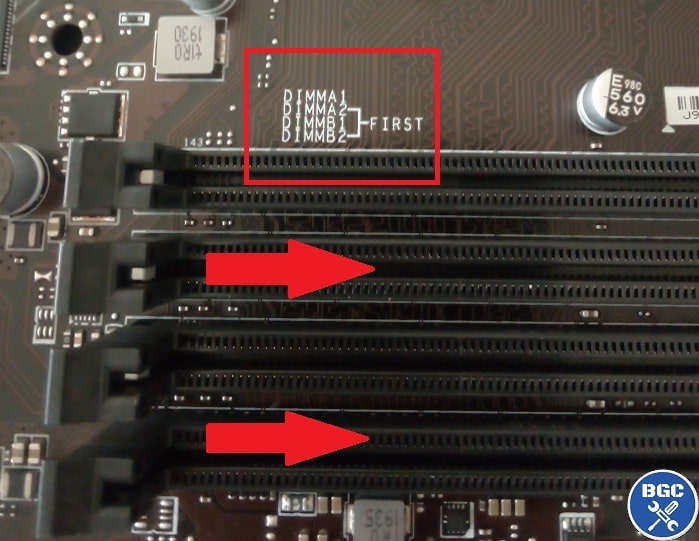Slots In Motherboard
- Sep 12, 2020 How to repair a RAM slot on the motherboard Turn your system off and unplug everything. Open the casing of the computer. If you are doing this for the first time, use the manual to do it right. Find the RAM slot and carefully remove the card. You will need to use both your hands to.
- A standard consumer ATX motherboard usually features seven expansion slots, spaced 0.7” apart, and four DIMM (memory) slots. Extended ATX or eATX (12” x 13”): A larger variant of the ATX form factor designed for enthusiast and professional use, these boards have additional real estate for more flexible hardware configurations.
- The first one I encountered was a couple of years ago - I opened up a brand new ITX celeron board and I eventually discovered that one of the RAM slots was bad. The motherboard wouldn't boot with any RAM installed in one of the two RAM slots on the motherboard - remove RAM from that slot, and the system booted fine with RAM in the other slot only.

When purchasing a new Server, Workstation or PC to support an expansion card one of the most important things to determine is what type of slot does the motherboard have. There are 3 types of slots that have been used for over the years: ISA, PCI, and PCI Express (PCIe). These are also the most common types of slots that computer motherboards have had for expansion cards. Let’s take a look at each of these:
Motherboard Expansion Slots AGP Slots. AGP stands for Accelerated Graphics Port, and this slot is commonly used for attaching graphics cards and 3D. PCI Express Slots. This is the newest version for such slots, and it has overtaken previous versions like AGP and PCI. PCI is the older. The RAM slots for many motherboards are limited to either two or four. In the latest upgrades of AMD motherboards, they were able to incorporate as many as eight RAM slots. With the help of these eight.
ISA Slots
The ISA Slots are shown in Green in image to the right. This is the oldest slot type that is still available today. Computers with ISA slots are no longer available from major computer manufacturers, Ram PC Systems still sells industrial class systems with ISA slots.
PCI Slots
Agp Slots In Motherboard
PCI slots were the replacment for ISA slots. The PCI Slots are shown in the Red box in the image. PCI slots come in several different versions including 5 volt and 3.3 volt slots, and 32-bit and 64-bit PCI-X slots. PCI slots are going away as well but are still available from some major computer manufacturers but they usually only offer one PCI slot. Ram PC Systems has several different systems available with 2 or more PCI slots.
Slots In Motherboard
PCI Express Slots
PCI Express slots are the replacement for PCI slots, and also AGP (used only for video cards). PCI Express, also labeled as PCIe come in numerous bus widths labeled: x1, x2, x4, x8, and x16.
Related Posts and Helpful Links

4. Northbridge: This allows communication between the CPU and the system memory and PCI-E slots. It is a focal Point of Motherboard and It is also called as Memory Controller Hub.
5. ATX 12V 2X and 4 Pin Power Connection : This is one of two power connections that supply power to the .motherboard This connection will come from your Power Supply.
6. CPU-Fan Connection: This is where the CPU fan will connect. Using this connection over one fof the power supply will allow the motherboard to control the speed of the fan, based on the CPU temperature.
7. Socket: This is where the CPU will plug in. The orange bracket that is surrounding it is used for high end heat sinks. It helps to support the weight of the heat sink.
8. DIMM slots: DIMM's are by far and away the most used memory types in today's computers. They vary in speeds and standards however and they need to match up to what your motherboard has been designed to take. The four standards of DIMM's being used at the moment are SDR (Single Data Rate), DDR (Double Data Rate), DDR2 and DDR3. The speeds of memory can vary between 66Mhz to 1600Mhz.
9. ATX Power Connector: This is the second of two power connections. This is the main power connection for the motherboard, and comes from the Power Supply.
10. IDE connectors or PATA connectors : IDE full form is Integrated Device Electronics. it supports IDE devices, such as Hard disks and CD and DVD drives. Most drives today come with SATA connections.
11. Southbridge: This is the controller for components such as the PCI slots, onboard audio, and USB connections.
12. SATA Connections : SATA full form is Serial Advanced Technology Attachment. These are connect with serial ATA devices, such as Hard disk drives and CD or DVD drives.
13. Front Panel Connections: this is where we will hook in the connections from the case. These are mostly the different lights on the case, such as power on, hard drive activity etc.

14. FDD Connection: The FDD is the Floppy Disk controller. Floppy Drive Connector is used to connect floppy drives. It supports two floppy drives.

15. External USB Connections: There are usually a couple of these ports located on each motherboard used for connecting pen drives and external hard drives, like Ipods or Mp3 players.
16. CMOS battery :This is the motherboard's battery, which is used to power the south bridge and the BIOS to save the setting, data and time.